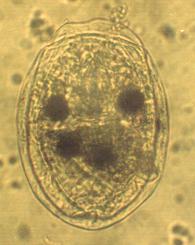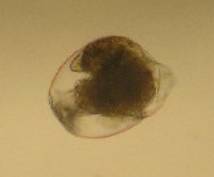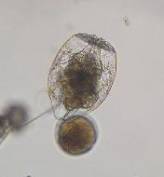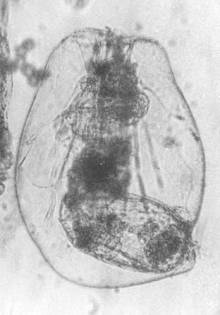GASTROPODIDAE, {REMANE, 1933) (family)
Jaws virgate. Mostly littoral and only a few planktonic species.
ASCOMORPHA, (PERTY 1850)
63 a. With sickle-shaped palp on head, used for holding pray
(e.g. Ceratium). Body ovate, more or less flattened
dorso-ventrally. Lorica slightly stiff, consisting of
dorsal and ventral plates covered with thin membrane.
Yellow-green coloured by chromatophores in stomach wall.
Stomach with four blind sacs. With 4 small dark masses
(accretion bodies). Size 100-200 μm, with 66-84 μm.
Food Ceratium. Maxima coincide with dinoflagellates blooms.
In Laguna de Bay it occurs during a bloom of flagellates
in October 1980. Ceratium is common in Laguna de Bay
(Nielsen, 1983, Petersen, 1981e). Eurytopic, tolerates
pH 5-9, 1-14 mg O2/L, abundant at 8-9 mg O2/L,
40-1585 μS cm-1 abundant at 150 μS cm-1
(Radwan & Bielanska-Grajner, 2002). In littoral and
plankton in lakes, ponds, and rivers, also in saline waters,
although it cannot handle a wide fluctuation in the salt
content of water.
- Laguna de Bay
Ascomorpha ovalis, (BERGENDAHL, 1892)
(syn. Chromogaster ovalis HARRING, 1913)
(syn. non Ascomorpha ecaudis PERTY, 1850).
[1980, 1984a]
A. ovalis from Laguna de Bay. (Photo: Flemming Petersen, 1980)
NOTE:
63 b. A similar species without palp on head. With 4
small dark masses (accretion bodies). Lorica
absent, i.e. cuticle thin and flexible, not
usually retaining its shape well after preservation.
Body sack-shaped, green coloured. Size 100 μm.
Food unicellular green algae, which are digested
intracellularly, or stay alive and multiply as
zoochlorella in the body wall. Eurytopic,
eurythermic, euryionic tolerates pH 4.0-9.2,
maximum abundance reached at pH 6.2. 1-14 mg O2/L,
conductivity up to 551 μS cm-1
(Radwan & Bielanska-Grajner, 2002). However,
Sládeček (1983) refer A. ecaudis as an indicator
of oligotrophic waters.
In littoral and plankton in lakes and ponds,
also in saline waters.
- Record not verifiable.
Ascomorpha ecaudis, (PERTY, 1850)
(syn. Sacculus viridus).
[1980, 1984a]cf.,
probably misdetermination]
ASPLANCHNIDAE, HARRING & MYERS 1926 (family)
Lorica absent, i.e. cuticle thin and flexible,
not usually retaining its shape well after
preservation. Large sack-shaped, with corona
(wheel organ) anteriorly. Rather big viviparous
rotifers Planktonic family. Jaws incudate.
Curved, sharp-pointed rami like pincers.
Seizing type. Intestine and anus absent. Asplanchna
releases a waterborne signal that induces spine
formation in several Brachionus and Keratella species
and Filinia longisecta (Snell, 1998), while the
presence of Asplanchna could be responsible for the
development of spines in these genera if present together.
Planktonic.
ASPLANCHNOPUS, DE GUERNE 1888
With foot. Prefer alkaline waters (Sládeček 1983).
64 a. Intestine and anus absent. Size 700-1000 μm.
Ovary horseshoe-shaped. Semiplanktonic in large
and small waters, sometimes numerous. Commen.
- Paoay Lake, Lake Lanao, Pasig River and
Quezon City: UP. Campus, Los Bańos.
University of Santo Tomas: abandoned pond
(Rey Donne S. Papa, private communication)
Asplanchnopus multiceps, (SCHRANK, 1793)
[1978a+b, 1986a, 2008b, 2009a]
A. multiceps (foto Rey Donne S. Papa)
A. multiceps (foto Rey Donne S. Papa)
A. multiceps (Photo by Rey Donne S. Papa, 2007)
ASPLANCHNA, GOSSE 1850
Without a foot. Feeds on particles larger than 10 μm like algae,
protozoa, other rotifers (Keratella) and small Cladocera likeBosmina, catching them individually. Prefer alkaline waters
(Sládeček 1983).
- Pasig River
[2009a]65 a. Without foot. Yolk gland (vitellarium) round.
Size 500-1500 μm. Feed on diatoms, dinoflagellatesand Chrysophyseae, but predate also on rotifers as
Keratella, Polyarthra and Anuraeopsis. Planktonic
in lakes and ponds, often numerous, also found in
brackish water.
ASPLANCHNA, SUDZUKI, 1964 or PRIODONTA GROUP.
Body length 250-1500 μm. Feeds on algae, ciliates
and small rotifers. Indicator of mesotrophic waters
(Sládeček, 1983). In waters with pH 4.5-8,
temperature up to 29oC.
- Laguna de Bay.
Asplanchna priodonta, (GOSSE, 1850)
[1941a, 1980, 1984a]
A. priodonta from Laguna de Bay
65 b. Without foot. Yolk gland horseshoe-shaped.
ASPLANCHNELLA, SUDZUKI, 1964 or GIRODI-BRIGHTWELLI GROUP.
Size 500-2500 μm. Feed on Volvocales, Chlorococcalesand several genera of rotifers including their own.
Diet can induce smaller morphoforms: form saccate andform cruciform (with lateral outgrowths to protect against
cannibalism), while the normal form is campanulata
(Wallace et al., 2006). Planktonic in freshwater,
also in brackish
- Calibato Lake, Tadlac Lake.
Asplanchna sieboldi (LEYDIG, 1854)
[1941a, 1980, 1984a]
To 66a




